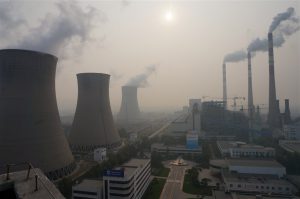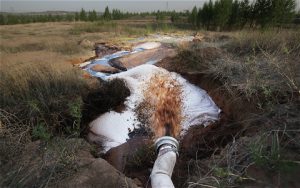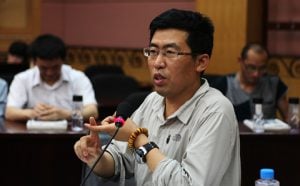China’s revised Environmental Protection Law, already written off by many during its long-winded drafting process, came through strong in the end.
It marks groundbreaking progress and has the potential to become a cornerstone for China’s “war on pollution”, recently declared by Premier Li Keqiang. Several years in the making, the revised law was adopted by the Standing Committee of the National People’s Congress on April 24. It will enter into force in 2015. The law will equip environmental authorities with several powerful and much needed instruments to solve China’s daunting environmental challenges. Now, it has to prove its worth in practice.
At the beginning of the revision process in 2011, the prospects that China would indeed formulate a strong Environmental Protection Law (EPL) were grim. While pressure was high to update the outdated and hopelessly insufficient law of 1989, traditional forces that wanted to water down the revised law seemed to come out on top once again. An ambitious initial proposal from the Ministry of Environmental Protection (MEP) was rejected flat out.
Instead, the NDRC and the Environmental Protection and Resources Conservation Committee of the National People’s Congress, as the most powerful representatives of economic interests, took over. The latter assumed the drafting responsibility. As a result, the Committee released a first public draft version in August 2012 that was highly disappointing from the view of environmental protection. If this had been the end of the story, it would have been a complete disaster for environmental regulation.
Luckily, at this point the revision process turned into an unprecedented case of public discourse directly impacting law formulation. A broad coalition of proponents of tighter environmental protection voiced their outrage against the weak draft. The MEP catalysed the public dissent and publicly released a list of 34 arguments countering the first draft. In an unexpected turn of events, the Environmental Protection and Resources Conservation Committee lost the drafting responsibility to the Law Committee of the National People’s Congress, which was more open to environmental interests. This remarkable victory of the MEP marked the declining dominance of the opponents to a strong law. Although still lacking in many aspects, the second draft version put forward by the Law Committee in mid-2013 clearly reflected this turn of the tide.
From mid-2013 on, the environmental proponents further increased their impact, leading an intense debate that delayed a quick approval of the draft. Although legislative procedures usually stipulate a maximum of three rounds of law reviews, the Standing Committee was forced to call a fourth extraordinary review in April 2014, marking an unheard off event in Chinese policymaking. From draft to draft, the revision group added further details strengthening the law.
Consequently, the final fourth draft had become something dramatically different from what observers expected at the beginning of the process three years earlier. It now contains many provisions that can, if implemented right, give a real boost to environmental protection in China. Moreover, the revision process itself signals change, highlighting the growing influence of environmental consideration in Chinese law making and the emerging channels for exerting this influence. Drawing the debate into the public sphere to mount pressure on the opponents was key to the success of environmental interest.
The process is an example for how a vivid debate that is open to the proposals of a wider audience can shape law making in China. If this stays a unique event or becomes a template for future deliberations on environmental governance in China remains to be seen.
The best parts of the new law
Three provisions can serve to illustrate the particular robustness of the law. The most forceful instrument it entails is a day-based punishment system. The law of 1989 allows environmental authorities only to impose one-time penalties on polluting enterprises. The maximum amount is very low, so the penalty does not represent a serious threat to enterprises if they refuse to comply. The revision now enables the Environmental Protection Bureaus to fine polluting enterprises on a daily basis as long as they fail to bring their operations in line with environmental regulations.
As there is no maximum limit for the fine, environmental authorities can now pose an existential threat to non-compliant enterprises. If this provision holds up in implementation, it can become a game changer for the power dynamic between environmental agencies and polluters.
Another noteworthy feature is the introduction of Environmental Impact Assessments (EIA) for plans and policies into the law. Until now, the EPL made only stipulations about project level impact assessments. Although China’s environmental regulation already contains provisions on EIAs for plans and policies, the EPL remained silent about these instruments. In consequence, the few existing examples of plan or policy level EIAs are rather the exception than the rule. As policy decisions frequently have far-reaching implications for the environment, the lack of systematic policy EIAs has been one of the big blind spots of environmental regulation in China. The new law now instructs central and provincial level governments to carry out EIAs for their economic and technological policies, closing an important gap.
Finally, the law formalises the possibility of public-interest environmental litigation. Experiments in the past with settling disputes through environmental courts faced difficulties due to the lack of a legal basis. The revised law will now provide such a basis. Throughout the law-drafting process, this aspect has undergone significant strengthening. Initial drafts attributed the right for litigation only to one NGO, the All-China Environment Federation, a de facto government-owned organisation subjugated to the MEP.
The protest from civil society, however, proved effective also on this point: the third draft version allowed all societal organisations registered with the Ministry of Civil Affairs to file lawsuits. Yet, as only few environmental NGOs, mostly with government background, are registered at the central level, this would have again excluded most NGOs. The ensuing dispute about this issue was one of the main reasons why the draft was forced into a fourth review. In the end, the approved law now allows all societal organisations registered with a Civil Affairs Bureau above city level to file lawsuits. In its final iteration, the provision has the potential to have an enormous impact, strengthening the influence of civil society on environmental protection in China.
In combination with a host of other improvements included in the law, these three changes will give environmental protection authorities real teeth.
What’s still missing
Despite the positive turn the reform process took, the revised law still missed some opportunities and faces many challenges. Most importantly, the ubiquitous question of implementation looms large also for the new EPL. The existing institutional setup will not make it any easier: local governments still tightly control Environmental Protection Bureaus in terms of personnel and finance, potentially creating difficult conditions for implementation. It is still uncertain to what extent local bureaus will be able to make use of the powerful weapons available to levy real punishments. It also remains to be seen whether the stipulation will foster a general trend towards EIA in legislation.
The biggest disappointment from the view of civil society, however, is that possibilities for environmental litigation remain limited. Since only organisations registered above the city-level will be able to launch lawsuits, many others will not be eligible for litigation. The NGO Friends of Nature has criticised the fact that many NGOs registered below the city-level or as enterprises, are excluded as barriers to registering NGOs are high. Luckily, the stipulation of previous drafts that only societal organisations with a “good reputation” be allowed to litigate did not feature in the final version of the law. This phrase was replaced by the condition that these organisations should “have no record of illegal activity”. Without this change, authorities would have had almost unlimited discretion to keep unloved organisations away from litigation.
The EPL is not a perfect law, but it is certainly much stronger than could have been expected and has the potential to influence the dynamics of environmental protection in China in a longlasting way. If the issuance of the law is supplemented by the much rumored expansion of the MEP’s sphere of influence, taking over environmental responsibilities from other ministries to integrate environmental management within one organisation, it could make the implementation of the law even stronger.
The EPL provides the environmental authorities with powerful instruments to lead China into a cleaner future. Now, it is their turn to make use of these instruments, taking an important step towards solving one of China’s biggest challenges in the 21st century.







